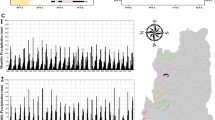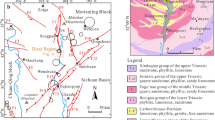Abstract
The Mahu lake, the third deepest lake in China, is located on the west bank of the Jinsha River in Leibo county, Sichuan Province. It is a dammed lake created by an old landslide on the ancient Huanglang river, a tributary on the west bank of the Jinsha River. Previous studies (Wang and Lu in J Mt Res S1:44–47, 2000) suggested that this landslide was caused by an earthquake approximately 372 ka (Middle Pleistocene), during which a few hundreds of million cubic meters of debris were deposited between 1177 and 900 m a.s.l. (above sea level), covering an area of around 15 km2. Our further investigations, including geodetic survey, borehole drilling, and field reconnaissance, combining with five chronological data, have made some new discoveries at this site. First, the toe of the landslide extends from 900 m a.s.l. down to 320 m a.s.l., i.e., the local bed elevation of the contemporary Jinsha River. Second, the area of the landslide deposits is 17.3 km2 with a volume of 2.38 km3, much larger than the previous estimation. Thus, it should be one of the largest known landslides in China. And the lower elevation of the landslide’s toe also rules out the possibility that it is a hanging valley on the ancient Huanglang river. Our work suggests that this landslide was created by five events according to the overlapping characteristics of the deposits and five chronological data, which are old than 52,600 years, old than 16,000 years, old than 15,500 years, 5800 years, and old than 4200 years, respectively.

















Similar content being viewed by others
References
Abele G (1974) Bergstürze in den Alpen: ihre Verbreitung, Morphologie und Folgeerscheinungen. Univ.-Verlag Wagner, Innsbruck
Beetham RD, McSaveney MJ, Read SAL (2002) Four extremely large landslides in New Zealand. Landslides 97–102
Dai FC, Tu XB, Xu C, Gong QM, Yao X (2011) Rock avalanches triggered by oblique-thrusting during the 12 May 2008 Ms 8.0 Wenchuan earthquake, China. Geomorphology 132(3):300–318
Department of Earthquake Disaster Prevention, State Seismological Bureau (ed) (1995) Catalogue of historical strong earthquakes of China. Seismological Press, Beijing (in Chinese)
Duman TY (2009) The largest landslide dam in Turkey: Tortum landslide. Eng Geol 104(1):66–79
Editorial Board of Brief Catalogue of Chinese Earthquake (2000) Brief catalogue of earthquake in China from 780 B.7. to 1986 A.D. Seismological Press, Beijing (in Chinese)
Han DR (1994) Mahu Lake and Mahu earthquake. Earthq Res China 10(1):97–98 (in Chinese)
Hancox GT, Perrin ND (1994) Green Lake landslide: a very large ancient rock slide in glaciated terrain, Fiordland, New Zealand. Institute of Geological and Nuclear Sciences Limited
Hancox GT, Perrin ND (2009) Green Lake landslide and other giant and very large postglacial landslides in Fiordland, New Zealand. Quatern Sci Rev 28(11):1020–1036
Harrison JV, Falcon NL (1938) An ancient landslip at Saidmarreh in southwestern Iran. J Geol 46:296–309
Heim A (1883) Der alte Bergsturz von Flims. Jb. d. Schweizer Alpenclubs 18:295–309
Hou ZH, Han DR, Liang JP (1999) Discussion on the problems of 1844 earthquake north OF Daguan. Yunnan Province Prog Geophys 14(1):78–83 (in Chinese)
Huang R (2009) Further examination on characteristics and formatiom mechanism of Daguangbao landslide. J Eng Geol 17(6):725–736
Huang RQ, Li WL (2009) Analysis of the geo-hazards triggered by the 12 May 2008 Wenchuan Earthquake, China. Bull Eng Geol Env 68(3):363–371
Ivy-Ochs S, Poschinger AV, Synal HA, Maisch M (2009) Surface exposure dating of the flims landslide, graubünden, switzerland. Geomorphology 103(1):104–112
Ji J (1994) Preliminary Analysis of Water Resources of Mahu Lake. J Lake Sci 6(2):115–123 (in Chinese)
Keefer DK (1994) The importance of earthquake-induced landslides to long-term slope erosion and slope-failure hazards in seismically active regions. Geomorphology 10(1):265–284
Lin HD, Wang AD, Xu GL (1990) Recheck report of the basic intensity of Xiangjiaba Hydropower Station in Jinsha River, pp 60–62 (in Chinese)
Liu HL (2004) Researches on combinative characteristics of spore-pollens and analysis of ancient climate in small lake since 1.6 thousand years ago. J Sichuan For Sci Technol 2(25):5–9 (in Chinese)
Pollet N (2004) Mouvements gravitaires rapides de grandes masses rocheuses: Apports des observations de terrain à la compréhension des processus de propagation et dépôt. Application aux cas de La Madeleine (Savoie, France), Flims (Grisons, Suisse) et Köfels (Tyrol, Autriche). Ecole des Ponts ParisTech
Poschinger A, Wassmer P, Maisch M (2006) The Flims rockslide: history of interpretation and new insights. Landslides from massive rock slope failure. Springer, Dordrecht, pp 329–356
Qin Y (2010) Research on the phenomenon of Huge Mahu Lake on the history of cartography. J Ethnol 1(2):74–85 (in Chinese)
Read SAL, Beetham RD, Riley PB (1992) Lake Waikaremoana barrier—a large landslide dam in New Zealand. In: Proceedings of 6th international symposium on landslides, pp 1481–1487
Shoaei Z, Ghayoumian J (1998) The largest debris flow in the world, Seimareh landslide, Western Iran. Environmental Forest Science. Springer, Dordrecht, pp 553–561
Wang YS, Lu Y (2000) The colluvial landslide accumulation and its environmental effects in Huanglang, Leibo. J Mt Res S1:44–47 (in Chinese)
Watson RA, Wright HE (1969) The Saidmarreh landslide, Iran. Geol Soc Am Spec Pap 123:115–140
Whitehouse IE (1983) Distribution of large rock avalanche deposits in the central Southern Alps, New Zealand. NZ J Geol Geophys 26(3):271–279
WP/WLI (International Geotechnical Societies UNESCO Working Party on World Landslide Inventory) (1990) A suggested method for reporting a landslide. Bull Int As Eng Geol 41:5–12
Zhang DS (1991) Mahu lake—a deep plateau lake to be developed. Sichuan Water Power 2:31–33 (in Chinese)
Acknowledgements
This work was supported by NSFC international cooperation project (Grant No. 41661134012).
Author information
Authors and Affiliations
Corresponding author
Rights and permissions
About this article
Cite this article
Cui, Y., Deng, J. & Xu, C. Volume estimation and stage division of the Mahu landslide in Sichuan Province, China. Nat Hazards 93, 941–955 (2018). https://doi.org/10.1007/s11069-018-3334-8
Received:
Accepted:
Published:
Issue Date:
DOI: https://doi.org/10.1007/s11069-018-3334-8




